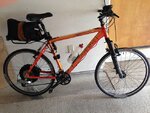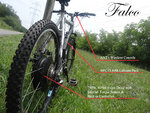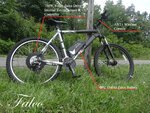James-Spokane
New Member
I bought (directly from Falco) a Falco 750 W HX motor with built in torque sensor and throttle control, a Falco 15 amp hour Lithium Naked Pack, and the wireless USB for adjusting settings from a computer. I installed it on my Trek aluminum frame mtn bike and added narrow 100 psi slicks for street use. Very powerful motor, and a sensitive throttle. After watching the You Tube videos by Falco owner Rakesh on how to use the wireless interface software to change the various motor settings, I have started dialing in the torque sensor settings that work best for me and started getting the feel of it. It seems to work fairly smoothly once you get it dialed in right. I would especially recommend buying the wireless USB to be able to customize the settings.
Uphills are especially smooth as the power is constant. On the flats you notice it as the power comes on and off, but if your settings are right it feels fairly natural. It’s possible to cruise along at pretty high speeds with as much or as little effort as you want, which makes it a real commuting machine.
Rakesh was very helpful in reprogramming the motor to improve the torque sensor operation. It looks like they are continuing to develop and improve the wireless interface software and will have more upgrades and features in the future (speed clamps, etc). I’m looking forward to experimenting with those also once they come out. Riding with throttle only is also very enjoyable, either with or without pedaling, depending on your desire. Since I have such a powerful battery (15 amp hours), I think it will be good for a long hilly ride with no risk of running out. So far I haven’t had a chance to take it on a long enough ride to deplete it much, just lots of shorter fast rides.
I think that the 500 W motor would have been plenty for me based on the power of this 750 W motor. In pedal assist mode assist level 2 is plenty for me. I can’t imagine using 4 or 5 in pedal assist unless I’m on a wide open straight road with no cars, or maybe going up a very very steep hill. But level 5 works fine with the throttle because you can control the power precisely. I do think the extra power of the 750 W motor though is nice to have though, in order to be able to throttle all the way up the long hill like we have here on the South Hill in Spokane.
I do have some issues between my wireless console and motor in terms of not staying paired, but Falco is sending me a new wireless transmitter module and says that they will fix that issue. I can’t wait. It will be great to change assist levels (and go to regen mode) on the fly from the console.
Since I mounted my big 15 aH naked pack on the rear rack, and the motor is in the back, the bike is obviously rear heavy, but it’s not too bad and is manageable. I believe Falco’s frame mounted battery would be ideal, and I believe now that their 48 V frame mount battery would be powerful enough and last long enough for most people. I was skeptical at first and that is why I bought the big naked pack.

Uphills are especially smooth as the power is constant. On the flats you notice it as the power comes on and off, but if your settings are right it feels fairly natural. It’s possible to cruise along at pretty high speeds with as much or as little effort as you want, which makes it a real commuting machine.
Rakesh was very helpful in reprogramming the motor to improve the torque sensor operation. It looks like they are continuing to develop and improve the wireless interface software and will have more upgrades and features in the future (speed clamps, etc). I’m looking forward to experimenting with those also once they come out. Riding with throttle only is also very enjoyable, either with or without pedaling, depending on your desire. Since I have such a powerful battery (15 amp hours), I think it will be good for a long hilly ride with no risk of running out. So far I haven’t had a chance to take it on a long enough ride to deplete it much, just lots of shorter fast rides.
I think that the 500 W motor would have been plenty for me based on the power of this 750 W motor. In pedal assist mode assist level 2 is plenty for me. I can’t imagine using 4 or 5 in pedal assist unless I’m on a wide open straight road with no cars, or maybe going up a very very steep hill. But level 5 works fine with the throttle because you can control the power precisely. I do think the extra power of the 750 W motor though is nice to have though, in order to be able to throttle all the way up the long hill like we have here on the South Hill in Spokane.
I do have some issues between my wireless console and motor in terms of not staying paired, but Falco is sending me a new wireless transmitter module and says that they will fix that issue. I can’t wait. It will be great to change assist levels (and go to regen mode) on the fly from the console.
Since I mounted my big 15 aH naked pack on the rear rack, and the motor is in the back, the bike is obviously rear heavy, but it’s not too bad and is manageable. I believe Falco’s frame mounted battery would be ideal, and I believe now that their 48 V frame mount battery would be powerful enough and last long enough for most people. I was skeptical at first and that is why I bought the big naked pack.




